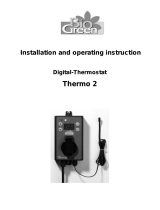
4
Safety precautions
Power supply line or circuit breaker
f If the power cable of this air conditioner is damaged, it must be replaced by service agent or similarly qualied persons in
order to avoid a hazard.
f The unit must be plugged into an independent circuit if applicable or connect the power cable to the auxiliary circuit
breaker. An all pole disconnection from the power supply must be incorporated in the xed wiring with a contact
opening of >3 mm (0.12 inch).
f The air conditioner must be installed in accordance with national wiring regulations and safety regulations wherever
applicable.
f The electric work must be done by service agent or similarly qualied persons according to national wiring regulations
and use only rated cable.
- If the capacity of the power cable is insucient or electric work is not properly completed, electric shock or re may
occur.
f Install the cables with supplied cables rmly. Fix them securely so that external force is not exerted to the terminal board.
- If the connection or xing is incomplete, heat generation, electric shock or re may occur.
f Connect the power cable between the indoor and outdoor unit properly so that the electrical component box cover is
not get loosen and attach the cover securely.
- If the the cover is attached incompletely, heat generation, electric shock or re of the terminal board may occur.
f Be sure not to perform power cable modication, extension wiring, and multiple wire connection.
- It may cause electric shock or re due to poor connection, poor insulation, or current limit override.
- When extension wiring is required due to power line damage, refer to “How to connect your extended power cables” in
the installation manual.
• Make sure that you earth the cables.
- Do not connect the earth wire to the gas pipe, water pipe, lighting rod or telephone wire. If earthing is not
complete, electric shock or re may occur.
• Install the circuit breaker.
- If the circuit breaker is not installed, electric shock or re may occur.
• Make sure that the condensed water dripping from the drain hose runs out properly and safely.
• Install the power cable and communication cable of the indoor and outdoor unit at least 1 m (3.28 ft) away from
the electric appliance.
• Install the indoor unit away from lighting apparatus using the ballast.
- If you use the wireless remote control, reception error may occur due to the ballast of the lighting apparatus.
• Do not install the air conditioner in following places.
- Place where there is mineral oil or arsenic acid. Resin parts ame and the accessories may drop or water may
leak. The capacity of the heat exchanger may reduce or the air conditioner may be out of order.
- The place where corrosive gas such as sulfurous acid gas generates from the vent pipe or air outlet. The copper
pipe or connection pipe may corrode and refrigerant may leak.
- The place where there is a machine that generates electromagnetic waves. The air conditioner may not
operate normally due to control system.
- The place where there is a danger of existing combustible gas, carbon ber or ammable dust. The place
where thinner or gasoline is handled. Gas may leak and it may cause re.
CAUTION




















